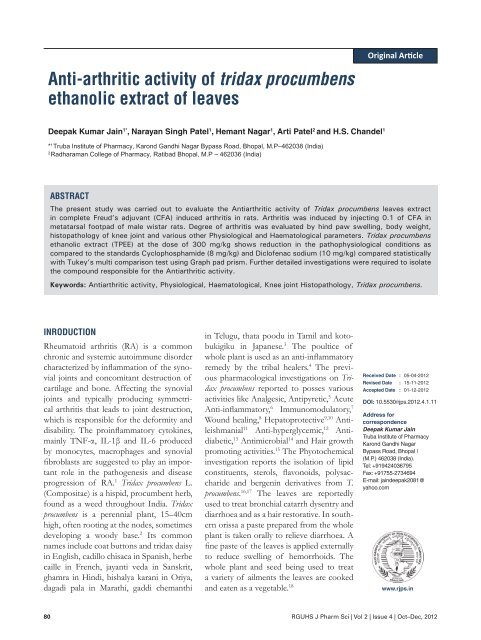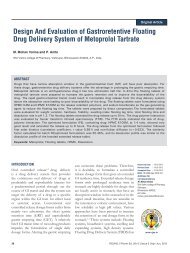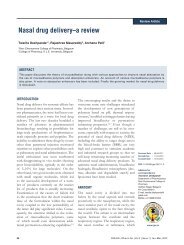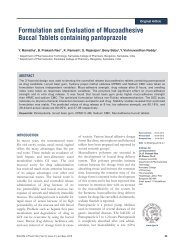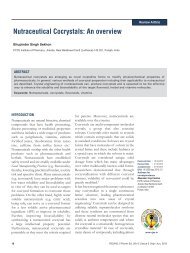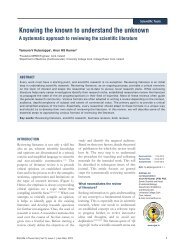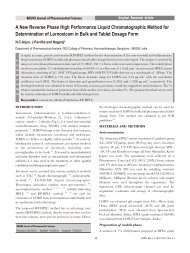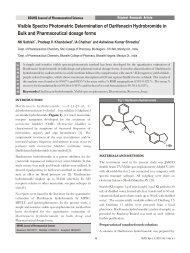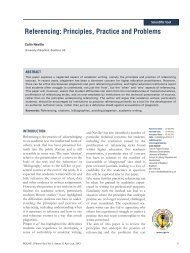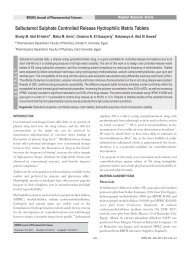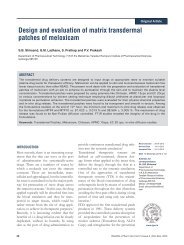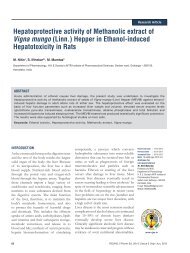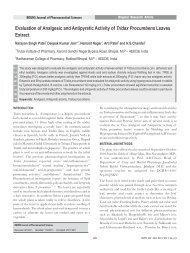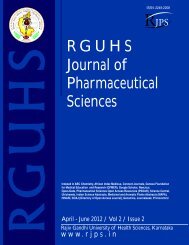Anti-arthritic activity of tridax procumbens ethanolic extract of leaves
Anti-arthritic activity of tridax procumbens ethanolic extract of leaves
Anti-arthritic activity of tridax procumbens ethanolic extract of leaves
Create successful ePaper yourself
Turn your PDF publications into a flip-book with our unique Google optimized e-Paper software.
<strong>Anti</strong>-<strong>arthritic</strong> <strong>activity</strong> <strong>of</strong> <strong>tridax</strong> <strong>procumbens</strong><br />
<strong>ethanolic</strong> <strong>extract</strong> <strong>of</strong> <strong>leaves</strong><br />
Deepak Kumar Jain 1* , Narayan Singh Patel 1 , Hemant Nagar 1 , Arti Patel 2 and H.S. Chandel 1<br />
* 1 Truba Institute <strong>of</strong> Pharmacy, Karond Gandhi Nagar Bypass Road, Bhopal, M.P–462038 (India)<br />
2 Radharaman College <strong>of</strong> Pharmacy, Ratibad Bhopal, M.P – 462036 (India)<br />
ABSTRACT<br />
INRODUCTION<br />
Rheumatoid arthritis (RA) is a common<br />
chronic and systemic autoimmune disorder<br />
characterized by infl ammation <strong>of</strong> the synovial<br />
joints and concomitant destruction <strong>of</strong><br />
cartilage and bone. Affecting the synovial<br />
joints and typically producing symmetrical<br />
arthritis that leads to joint destruction,<br />
which is responsible for the deformity and<br />
disability. The proinfl ammatory cytokines,<br />
mainly TNF-α, IL-1β and IL-6 produced<br />
by monocytes, macrophages and synovial<br />
fi broblasts are suggested to play an important<br />
role in the pathogenesis and disease<br />
progression <strong>of</strong> RA. 1 Tridax <strong>procumbens</strong> L.<br />
(Compositae) is a hispid, procumbent herb,<br />
found as a weed throughout India. Tridax<br />
<strong>procumbens</strong> is a perennial plant, 15–40cm<br />
high, <strong>of</strong>ten rooting at the nodes, sometimes<br />
developing a woody base. 2 Its common<br />
names include coat buttons and <strong>tridax</strong> daisy<br />
in English, cadillo chisaca in Spanish, herbe<br />
caille in French, jayanti veda in Sanskrit,<br />
ghamra in Hindi, bishalya karani in Oriya,<br />
dagadi pala in Marathi, gaddi chemanthi<br />
in Telugu, thata poodu in Tamil and kotobukigiku<br />
in Japanese. 3 The poultice <strong>of</strong><br />
whole plant is used as an anti-infl ammatory<br />
remedy by the tribal healers. 4 The previous<br />
pharmacological investigations on Tridax<br />
<strong>procumbens</strong> reported to posses various<br />
activities like Analgesic, <strong>Anti</strong>pyretic, 5 Acute<br />
<strong>Anti</strong>-infl ammatory, 6 Immunomodulatory, 7<br />
Wound healing, 8 Hepatoprotective 9,10 <strong>Anti</strong>leishmanial<br />
11 <strong>Anti</strong>-hyperglycemic, 12 <strong>Anti</strong>diabetic,<br />
13 <strong>Anti</strong>microbial 14 and Hair growth<br />
promoting activities. 15 The Phyotochemical<br />
investigation reports the isolation <strong>of</strong> lipid<br />
constituents, sterols, fl avonoids, polysaccharide<br />
and bergenin derivatives from T.<br />
<strong>procumbens</strong>. 16,17 The <strong>leaves</strong> are reportedly<br />
used to treat bronchial catarrh dysentry and<br />
diarrhoea and as a hair restorative. In southern<br />
orissa a paste prepared from the whole<br />
plant is taken orally to relieve diarrhoea. A<br />
fi ne paste <strong>of</strong> the <strong>leaves</strong> is applied externally<br />
to reduce swelling <strong>of</strong> hemorrhoids. The<br />
whole plant and seed being used to treat<br />
a variety <strong>of</strong> ailments the <strong>leaves</strong> are cooked<br />
and eaten as a vegetable. 18<br />
Original Ar cle<br />
The present study was carried out to evaluate the <strong>Anti</strong><strong>arthritic</strong> <strong>activity</strong> <strong>of</strong> Tridax <strong>procumbens</strong> <strong>leaves</strong> <strong>extract</strong><br />
in complete Freud’s adjuvant (CFA) induced arthritis in rats. Arthritis was induced by injecting 0.1 <strong>of</strong> CFA in<br />
metatarsal footpad <strong>of</strong> male wistar rats. Degree <strong>of</strong> arthritis was evaluated by hind paw swelling, body weight,<br />
histopathology <strong>of</strong> knee joint and various other Physiological and Haematological parameters. Tridax <strong>procumbens</strong><br />
<strong>ethanolic</strong> <strong>extract</strong> (TPEE) at the dose <strong>of</strong> 300 mg/kg shows reduction in the pathophysiological conditions as<br />
compared to the standards Cyclophosphamide (8 mg/kg) and Dicl<strong>of</strong>enac sodium (10 mg/kg) compared statistically<br />
with Tukey’s multi comparison test using Graph pad prism. Further detailed investigations were required to isolate<br />
the compound responsible for the <strong>Anti</strong><strong>arthritic</strong> <strong>activity</strong>.<br />
Keywords: <strong>Anti</strong><strong>arthritic</strong> <strong>activity</strong>, Physiological, Haematological, Knee joint Histopathology, Tridax <strong>procumbens</strong>.<br />
Received Date : 05-04-2012<br />
Revised Date : 15-11-2012<br />
Accepted Date : 01-12-2012<br />
DOI: 10.5530/rjps.2012.4.1.11<br />
Address for<br />
correspondence<br />
Deepak Kumar Jain<br />
Truba Institute <strong>of</strong> Pharmacy<br />
Karond Gandhi Nagar<br />
Bypass Road, Bhopal |<br />
(M.P.) 462038 (India).<br />
Tel: +919424036795<br />
Fax: +91755-2734694<br />
E-mail: jaindeepak2081@<br />
yahoo.com<br />
www.rjps.in<br />
80 RGUHS J Pharm Sci | Vol 2 | Issue 4 | Oct–Dec, 2012
Deepak Kumar Jain et al.: <strong>Anti</strong>-Arthritic Activity <strong>of</strong> Tridax Procumbens Ethanolic Extract <strong>of</strong> Leaves<br />
The designed work can be rationalize as, <strong>Anti</strong>oxidant 4<br />
property <strong>of</strong> Tridax <strong>procumbens</strong>, Activity against<br />
Analgesia, Pyrexia 5 and Infl ammation 6 as well as<br />
presence <strong>of</strong> sterols and fl avanoids provide a view that<br />
the active constituents <strong>of</strong> Tridax <strong>procumbens</strong> can also<br />
have <strong>activity</strong> against arthritis, hence the aim <strong>of</strong> present<br />
study is to evaluate the in- vivo antiarthiritic <strong>activity</strong><br />
<strong>of</strong> Tridax <strong>procumbens</strong> leaf <strong>extract</strong> by adjuvant arthritis<br />
assays in rats.<br />
MATERIAL AND METHODS<br />
The plant was collected in the month <strong>of</strong> September-<br />
October 2010 from the fi elds <strong>of</strong> village Mau, Dist<br />
Narsinghpur (M.P). It was authenticated by Pr<strong>of</strong>.<br />
A.B.Tiwari, Head <strong>of</strong> Department <strong>of</strong> Crop and Herbal<br />
Physiology, Jawaharlal Nehru Krishi Vishwavidyalaya,<br />
Jabalpur (M.P.) and the specimen voucher no. assigned<br />
was DCHP/1610/Sep10/JNKV. The <strong>leaves</strong> were dried<br />
under shade and pulverized to coarse powder which was<br />
passed through sieve No.20 to maintain uniformity and<br />
further <strong>extract</strong>ed with 90% ethanol and ethyl acetate<br />
by hot <strong>extract</strong>ion process using soxhlet apparatus at<br />
55–60ºC for 35 complete cycles. 7<br />
Animals care and handling<br />
The experiment was carried out on wistar albino rats<br />
<strong>of</strong> either sex <strong>of</strong> weight 150 ± 20 grams. They were<br />
provided from Truba Institute <strong>of</strong> Pharmacy, Bhopal and<br />
were acclimatized to the standard laboratory conditions<br />
in well cross ventilated animal house at temperature<br />
25 ± 2°C relative humidity 44–56% and light and dark<br />
cycles <strong>of</strong> 13 and 11 hours respectively for 1 week before<br />
and during the experiment. They were fed with standard<br />
diet (Golden Feeds, Delhi) and water ad libitum. The<br />
experiment was approved by the Institutional Animal<br />
Ethics Committee and as per CPCSEA guidelines<br />
(approval no. 1196/a/08/CPCSEA).<br />
Drugs and chemicals<br />
Dicl<strong>of</strong>enac sodium provided by Novartis pharmaceuticals<br />
Pvt. Ltd, Cyclophosphamide provided by Cadila<br />
healthcare Ltd., Complete Freund’s adjuvant (Sigma)<br />
and RA test kit (Span) were purchased and all other<br />
chemicals utilized were <strong>of</strong> analytical grade.<br />
Table 1: Animal grouping and their drug administration protocol<br />
Acute toxicity studies<br />
The LD was calculated by “Staire case” method.<br />
50<br />
The LD was determined in rats and mice by oral and<br />
50<br />
intraperitoneal route. The initial dosing was 2000 mg/kg<br />
p.o. and 800 mg/kg i.p. in both the species. 5 On the basis<br />
<strong>of</strong> above study the dose 300 mg/kg P.O. was selected<br />
for the further study.<br />
Preparation <strong>of</strong> <strong>extract</strong> dose<br />
2% acacia suspension was prepared by suspending 2<br />
gram <strong>of</strong> accurately weighed acacia powder in 100 ml <strong>of</strong><br />
0.9% saline. 20 ml <strong>of</strong> vehicle was taken separately to<br />
which 2 gram <strong>of</strong> dried <strong>extract</strong> was added and sonicated,<br />
this produce suspension <strong>of</strong> 100 mg/ml strength. Both<br />
Tridax <strong>procumbens</strong> <strong>ethanolic</strong> <strong>extract</strong> (TPEE) and Tridax<br />
<strong>procumbens</strong> ethyl acetate <strong>extract</strong> (TPEAE) suspension<br />
were prepared in such manner.<br />
Animal grouping<br />
Screening <strong>of</strong> <strong>Anti</strong>-<strong>arthritic</strong> <strong>activity</strong> in rats by<br />
Adjuvant arthritis model<br />
Physiological screening<br />
On day 0, 0.1 ml <strong>of</strong> complete Freund’s adjuvant was<br />
injected into the sub plantar region <strong>of</strong> the left hind paw<br />
<strong>of</strong> all the animals. Dosing with the test and the standard<br />
drugs were started on the same day and continued for<br />
14 days. From day 14 to 21 the animals were not dosed<br />
with the test compound and the standard drugs. Body<br />
weights <strong>of</strong> animals <strong>of</strong> all the groups were periodically<br />
monitored by using electronic balance on 0th 7th, 14th<br />
and 21st day. The paw was marked with ink at the level<br />
<strong>of</strong> the lateral malleolus and immersed in mercury up<br />
to this mark and measured plethysmographically (a U<br />
shaped instrument fi lled with mercury held upto a fi xed<br />
height) immediately after injection and on 7th, 14th and<br />
21st day. No. <strong>of</strong> nodes were also monitored at the same<br />
interval. 19,20<br />
Haematological screening<br />
On 21st day the animals were sacrifi ced as per the<br />
norms <strong>of</strong> CPCSEA guidelines by the physical method<br />
<strong>of</strong> euthanasia (cervical dislocation) and their blood<br />
sample was collected for testing various haematological<br />
parameters such as WBCs, RBCs, ESR, Hb and RF. ESR<br />
Group No. TREATMENT DOSE<br />
I (Negative control) CFA + Vehicle 0.1 ml(SP) + 1 ml/100gm/P.O.<br />
II (Standard 1) CFA + Dicl<strong>of</strong>enac sodium 0.1 ml(SP) + 10 mg/kg I.P.<br />
III (Standard 2) CFA + Cyclophosphamide 0.1 ml(SP) + 8 mg/kg I.P.<br />
IV (Test 1) CFA +TPEE 0.1 ml(SP) + 300 mg/ kg P.O.<br />
V (Test 2) CFA + TPEAE 0.1 ml(SP) + 300 mg/ kg P.O.<br />
CFA- Complete Freund ’s adjuvant, TPEE-Tridax <strong>procumbens</strong> <strong>ethanolic</strong> <strong>extract</strong>, TPEAE- Tridax <strong>procumbens</strong> ethyl acetate <strong>extract</strong>, SP- sub plantar, I.P.-Intra peritoneal, P.O. - Per oral.<br />
RGUHS J Pharm Sci | Vol 2 | Issue 4 | Oct–Dec, 2012 81
Deepak Kumar Jain et al.: <strong>Anti</strong>-Arthritic Activity <strong>of</strong> Tridax Procumbens Ethanolic Extract <strong>of</strong> Leaves<br />
was estimated by using Westergern tube having range<br />
<strong>of</strong> graduation 0–200 mm, height <strong>of</strong> blood column 200<br />
mm, length 300 mm, internal diameter 2.5 mm. One<br />
ml blood sample was fi lled in the tube previously fused<br />
with anticoagulant solution and allowed to fi x vertically<br />
in sedimentation rate rack for a hour. 21 WBCs were<br />
counted by sucking blood sample upto 0.5 mark in the<br />
WBC diluting pipette and holded horizontally, diluted<br />
using WBC diluting fl uid upto 100 mark and shaked for<br />
10 seconds, counting chamber was charged, 2–3 drops<br />
placed on the neuber slide and investigated under medical<br />
microscope. 21 RBCs were counted by sucking blood<br />
sample in RBC diluting pipette upto 0.5 mark and holded<br />
horizontally, and then RBC diluting fl uid was taken upto<br />
mark 100, counting chamber was charged, sample was<br />
placed on neuber slide and investigated under medical<br />
microscope. 21 Haemoglobin determination involves<br />
determination <strong>of</strong> percentage <strong>of</strong> haemoglobin present in<br />
blood sample. Numbers <strong>of</strong> method are available for its<br />
estimation among which colorimetric method was used<br />
by using visual haemoglobinometer. The visual method<br />
<strong>of</strong> Hb determination is called as Shali-Hellige Method.<br />
Graduated tube was fi lled upto mark with 0.1N HCl then<br />
20 cu mm <strong>of</strong> blood sample was added in it. Then the<br />
content <strong>of</strong> graduated tube was diluted until the colour<br />
<strong>of</strong> the solution matches with the standard colour strips.<br />
Sedimented volume in the tube was observed. 21 RF test<br />
was carried out by using RA Test Kit. Blood sample <strong>of</strong><br />
animals were collected, serum separated out. Positive<br />
control serum was spotted on two circles <strong>of</strong> RA test<br />
slide. The standard antigen (RA test antigen, consist <strong>of</strong><br />
polystyrene latex particles with specially purifi ed human<br />
gammaglobulins). Sample serum was placed on the<br />
separate circles <strong>of</strong> RA test slide by using the disposable<br />
plastic droppers, mixed well with a disposable applicator<br />
stick not more than two minutes and the agglutination<br />
was examined. Sample <strong>of</strong> all animals in each group were<br />
examined. Test was interpretated as follows; Coarse<br />
agglutination (usually occurs within one minute) -<br />
Strongly positive, Finer agglutination- Weakly positive,<br />
Smooth suspension, without any major change (usually<br />
takes full two minutes) - Negative. 22<br />
Knee joint Histopathology<br />
On the 21st day the animals were sacrifi ced as per the<br />
norms <strong>of</strong> CPCSEA guidelines by the physical method<br />
<strong>of</strong> euthanasia (cervical dislocation). The hind paws<br />
were dissected out. Fragments <strong>of</strong> tarso-metatarsal joints<br />
were collected and fi xed in 10% buffered formalin.<br />
The fragments were then treated with a 10% acidic<br />
nitric solution for decalcifi cation, dehydrated, cleared,<br />
embedded in paraffi n, 3–4 mm thick sections were cut<br />
and stained with Haematoxylin and Eosin. Synovial<br />
infl ammation, juxta-articular erosion, accumulation <strong>of</strong><br />
neutrophils, granulamotous tissue, tendon and skeletal<br />
muscle infl ammation were observed. The joints <strong>of</strong> at<br />
least three animals were observed in each experimental<br />
group. 23<br />
Statistical Analysis<br />
The results were expressed as mean ±SEM. The results<br />
<strong>of</strong> the present study were analyzed using one way<br />
ANOVA followed by Tukey’s multiple comparison test<br />
computed statically by using Graph pad prism s<strong>of</strong>tware<br />
(version 5.04) at p
Deepak Kumar Jain et al.: <strong>Anti</strong>-Arthritic Activity <strong>of</strong> Tridax Procumbens Ethanolic Extract <strong>of</strong> Leaves<br />
Table 2: Effects <strong>of</strong> TPEE and TPEAE on Paw volume against CFA induced arthritis in rats.<br />
Data <strong>of</strong> Paw Volume in ml (Mean ± SEM)<br />
GROUP DAY 0 DAY 7 DAY 14 DAY 21<br />
I 0.22 ± 0.011 0.86 ± 0.058 0.93 ± 0.064 0.86 ± 0.083<br />
II 0.24 ± 0.013 0.36 ± 0.088a ** 0.36 ± 0.105a ** 0.30 ± 0.089a **<br />
III 0.25 ± 0.016 0.31 ± 0.097a ** 0.37 ± 0.096a ** 0.075a **<br />
IV 0.20 ± 0.010 0.38 ± 0.090a ** 0.35 ± 0.086a ** 0.39 ± 0.092a *<br />
V 0.23 ± 0.010 0.43 ± 0.091a * 0.42 ± 0.091a ** 0.45 ± 0.011a *<br />
N = 6, Data expressed as mean ± SEM, One way ANOVA followed by Tukey’s multiple comparison test.<br />
a-comparison with group I(negative control) <strong>of</strong> all groups, b-comparison with Group II(Std. 1) <strong>of</strong> IV & V Groups<br />
c-comparison with Group III(Std.2) <strong>of</strong> IV & V Groups,***P
Deepak Kumar Jain et al.: <strong>Anti</strong>-Arthritic Activity <strong>of</strong> Tridax Procumbens Ethanolic Extract <strong>of</strong> Leaves<br />
rats joints showed normal bone structure mild<br />
periarticular infl ammation with nil edema around<br />
areas <strong>of</strong> bone, bone destruction negligible, synovial<br />
membrane depletion negligible as well as no periosteal<br />
proliferation with less cellular infi ltrates. TPEE treated<br />
group showed better histology than TPEAE treatment<br />
for 21 days as there were less infl ammatory signs like<br />
scanty cellular infi ltrate, absence <strong>of</strong> edema formation<br />
and normal done along with synovial membrane.<br />
Histopathological analysis<br />
Figure 1: Group I Negative control (CFA + Vehicle treated)<br />
Photomicrograph <strong>of</strong> knee joint from adjuvant <strong>arthritic</strong> rat 21 days<br />
post-adjuvant injection at the sub plantar region <strong>of</strong> left hind paw.<br />
Severe periarticular inflammation with marked edema is present<br />
around areas <strong>of</strong> bone, bone destruction, synovial membrane<br />
depletion as well as periosteal proliferation (magnification= 10X).<br />
Figure 2: Group II STD. 1 (CFA + Dicl<strong>of</strong>enac sodium treated)<br />
Photomicrograph <strong>of</strong> knee joint from adjuvant <strong>arthritic</strong> rat 21 days<br />
post-adjuvant injection at the sub plantar region <strong>of</strong> left hind paw.<br />
Mild periarticular inflammation with nil edema around areas <strong>of</strong><br />
bone, boney destruction not seen, prompt synovial membrane<br />
depletion, mild surrounding tissue injury but no periosteal proliferation<br />
(magnification= 10X).<br />
Figure 3: Group III STD. 2 (CFA + Cyclophosphamide treated) Photomicrograph<br />
<strong>of</strong> knee joint from adjuvant <strong>arthritic</strong> rat 21 days postadjuvant<br />
injection at the sub plantar region <strong>of</strong> left hind paw. Mild<br />
periarticular inflammation with nil edema around areas <strong>of</strong> bone,<br />
bone destruction negligible, synovial membrane depletion negligible<br />
as well as no periosteal proliferation (magnification= 10X).<br />
Figure 4: Group IV Test 1 (CFA + Tridax <strong>procumbens</strong> <strong>ethanolic</strong> <strong>extract</strong><br />
treated) Photomicrograph <strong>of</strong> knee joint from adjuvant <strong>arthritic</strong><br />
rat 21 days post-adjuvant injection at the sub plantar region <strong>of</strong> left<br />
hind paw. Mild periarticular inflammation with nil edema around<br />
areas <strong>of</strong> bone, boney destruction not seen, mild synovial membrane<br />
depletion, prompt surrounding tissue injury but no periosteal<br />
proliferation (magnification= 10X).<br />
DISCUSSION<br />
Rat adjuvant arthritis is an experimental model <strong>of</strong><br />
polyarthritis which has been widely used for preclinical<br />
testing <strong>of</strong> numerous anti-<strong>arthritic</strong> agents which are either<br />
under preclinical or clinical investigation or are currently<br />
used as therapeutics in this disease. The hallmarks <strong>of</strong><br />
this model are reliable onset and progression <strong>of</strong> robust,<br />
easily measureable, polyarticular infl ammation, marked<br />
bone resorption and periosteal bone proliferation.<br />
Cartilage destruction occurs but is disproportionally<br />
mild in comparison to the infl ammation and bone<br />
84 RGUHS J Pharm Sci | Vol 2 | Issue 4 | Oct–Dec, 2012
Deepak Kumar Jain et al.: <strong>Anti</strong>-Arthritic Activity <strong>of</strong> Tridax Procumbens Ethanolic Extract <strong>of</strong> Leaves<br />
Figure 5: Group V Test 2 (CFA + Tridax <strong>procumbens</strong> ethyl acetate<br />
<strong>extract</strong> treated) Photomicrograph <strong>of</strong> knee joint from adjuvant<br />
<strong>arthritic</strong> rat 21 days post-adjuvant injection at the sub plantar region<br />
<strong>of</strong> left hind paw. Mild periarticular inflammation with nil edema<br />
around areas <strong>of</strong> bone, boney destruction, synovial membrane<br />
depletion, surrounding tissue injury but no periosteal proliferation<br />
(magnification= 10X).<br />
destruction that occurs. 20 The parameters assessed in<br />
the anti <strong>arthritic</strong> study were physiological parameters,<br />
haematological parameters and histopathological study<br />
<strong>of</strong> knee joints. Complete Freund’s adjuvant was used to<br />
induce arthritis in rats; 0.1ml <strong>of</strong> it was injected in the<br />
sub plantar region <strong>of</strong> the left hind paw considered as<br />
day 0, treatment started on the same day till 14th day.<br />
The animals <strong>of</strong> all groups subjected to their respective<br />
treatment to evaluate the prophylactic use <strong>of</strong> test drug.<br />
Graph 2: Effects <strong>of</strong> TPEE and TPEAE on Number <strong>of</strong> Nodes against CFA induced arthritis in rats.<br />
In the present study, the rats were selected to induce<br />
arthritis because rats develop a chronic swelling in<br />
multiple joints with the infl uence <strong>of</strong> infl ammatory cells,<br />
erosion <strong>of</strong> joint cartilage and bone destruction. It has<br />
close similarities to human rheumatoid disease. 24 These<br />
mediators are responsible for the pain, destruction<br />
<strong>of</strong> bone and cartilage that can leads to severe<br />
disability. 25 However, the standard drug Dicl<strong>of</strong>enac<br />
sodium, Cyclophosphamide and the <strong>ethanolic</strong> <strong>extract</strong><br />
signifi cantly suppressed the swelling <strong>of</strong> the rat paws. In<br />
<strong>arthritic</strong> condition, there is a mild to moderate rise in<br />
WBC count due to the release <strong>of</strong> IL-IB infl ammatory<br />
response, IL-IB increases the production <strong>of</strong> both<br />
granulocyte and macrophages colony stimulating<br />
factors. 25,26 In the present study, the migration <strong>of</strong><br />
leucocytes into the infl amed area is signifi cantly<br />
suppressed by TPEE when compared to standard<br />
drug Dicl<strong>of</strong>enac sodium, Cyclophosphamide, as seen<br />
from the signifi cant reduction in the total WBC count.<br />
Erythrocyte Sedimentation Rate (ESR) is an estimate <strong>of</strong><br />
the suspension stability <strong>of</strong> RBC’s in plasma. It is related<br />
to the number and size <strong>of</strong> the red cells and to the relative<br />
concentration <strong>of</strong> plasma proteins, especially fi brinogen,<br />
alpha and beta globulins. Increase in the rate, is an<br />
indication <strong>of</strong> active but obscure disease processes. The<br />
acute phase proteins in ESR and C-Reactive Proteins<br />
(CRP) share the property <strong>of</strong> showing elevations in the<br />
concentration in response to stress or infl ammations<br />
like injection, injury, and surgery and tissue necrosis.<br />
The ESR count signifi cantly increased in <strong>arthritic</strong><br />
control group, whereas these counts were remarkably<br />
RGUHS J Pharm Sci | Vol 2 | Issue 4 | Oct–Dec, 2012 85
Deepak Kumar Jain et al.: <strong>Anti</strong>-Arthritic Activity <strong>of</strong> Tridax Procumbens Ethanolic Extract <strong>of</strong> Leaves<br />
counteracted in the standard Dicl<strong>of</strong>enac sodium,<br />
Cyclophosphamide and ethanol <strong>extract</strong> groups and thus<br />
justifying its signifi cant role in the <strong>arthritic</strong> conditions. 26<br />
Changes in body weight have also been used to assess<br />
the course <strong>of</strong> the disease and the response to therapy<br />
<strong>of</strong> anti-infl ammatory drugs. 27 As the incidence and<br />
severity <strong>of</strong> arthritis increased, the changes in the body<br />
weights <strong>of</strong> the rats also occurred during the course <strong>of</strong><br />
the experimental period. The loss <strong>of</strong> the body weight<br />
during <strong>arthritic</strong> condition was also supported by earlier<br />
observations, 28 on alterations in the metabolic activities<br />
<strong>of</strong> diseased rats. Earlier fi ndings suggest that absorption<br />
<strong>of</strong> 14C-glucose and 14C-leucine in rat’s intestine was<br />
reduced in the case <strong>of</strong> infl amed rats. 29 Treatment with<br />
anti-infl ammatory drugs, the decrease in absorption<br />
was nullifi ed 30 and it shows that the anti-infl ammatory<br />
drugs have corrected the decreased absorption capacity<br />
<strong>of</strong> intestine during infl ammation. The increased body<br />
weight during the treatment <strong>of</strong> standard drug and TPEE<br />
may be due to the restoration <strong>of</strong> the absorption capacity<br />
<strong>of</strong> the intestine.<br />
CONCLUSION<br />
From the obtained results <strong>of</strong> the current investigation,<br />
it may be concluded that the TPEE at the dose <strong>of</strong> 300<br />
mg/kg posses signifi cant anti-<strong>arthritic</strong> <strong>activity</strong> while<br />
TPEAE was less active, also the results <strong>of</strong> TPEE and<br />
cyclophosphamide were a bit similar which reveals that<br />
<strong>ethanolic</strong> <strong>extract</strong> might posses anti<strong>arthritic</strong> <strong>activity</strong> due to<br />
presence <strong>of</strong> sterols. The presence <strong>of</strong> phytoconstituents<br />
such steroids and fl avonoids might be responsible<br />
the anti-<strong>arthritic</strong> property. The study needs further<br />
extension to identify and characterize the exact active<br />
phytoconstituents and to elucidate the exact mechanism<br />
<strong>of</strong> action, which is responsible for the observed<br />
signifi cant anti-<strong>arthritic</strong> <strong>activity</strong> against adjuvant induced<br />
arthritis in rats.<br />
REFERENCES<br />
1. Sally J, Davies N, Jane. Worthington genes for rheumatoid arthritis <strong>of</strong>fer<br />
new insights into disease mechanisms. Drug discovery today: disease<br />
mechanisms 2005; 2:56–62.<br />
2. Suseela L, Sarsvathy A, Brindha P. Pharmacognostic studies on Tridax<br />
<strong>procumbens</strong> L. (Asteraceae). Journal <strong>of</strong> Phytological Research 2002;<br />
15:141–147.<br />
3. Saxena VK, Albert S. Β-Sitosterol-3-O-β-D-xylopyranoside from the<br />
fl owers <strong>of</strong> Tridax <strong>procumbens</strong> Linn. J Chem Sci. 2005; 117:263–266.<br />
4. Jachak SM, Gautam R, Selvam C, Madhan H, Srivastava A, Khan T.<br />
<strong>Anti</strong>-infl ammatory, cyclooxygenase inhibitory and antioxidant activities<br />
<strong>of</strong> standardized <strong>extract</strong>s <strong>of</strong> Tridax <strong>procumbens</strong> L. Fitoterapia. 2011;<br />
82:173–177.<br />
5. Jain DK, Patel NS, Nagar H, Patel A, Chandel HS. Evaluation <strong>of</strong><br />
Analgesic and <strong>Anti</strong>pyretic Activity <strong>of</strong> Tridax Procumbens Leaves<br />
Extract, RGUHS J Pharm Sci. 2011; 1:226–231.<br />
6. Margaret I, Srinivasa RP, Kaiser J. <strong>Anti</strong>infl ammatory pr<strong>of</strong>i le <strong>of</strong> Tridax<br />
<strong>procumbens</strong> in animal and fi broblast cell models. Phytother Res. 1998;<br />
12:285–287.<br />
7. Tiwari U, Rastogi B, Singh P, Saraf DK, Vyas SP. Immunomodulatory<br />
effects <strong>of</strong> aqueous <strong>extract</strong> <strong>of</strong> Tridax <strong>procumbens</strong> in experimental<br />
animals. J Ethnopharmacol. 2004; 92:113–119.<br />
8. Diwan PV, Tillo LD, Kulkarni DR. Infl uence <strong>of</strong> Tridax <strong>procumbens</strong> on<br />
wound healing. Ind J Med Res. 1982; 75:460–446.<br />
9. Ravikumar V, Shivashangari KS, Devaki T. Hepatoprotective <strong>activity</strong><br />
<strong>of</strong> Tridax <strong>procumbens</strong> against d-galactosamine/lipopolysaccharideinduced<br />
hepatitis in rats. J Ethnopharmacol. 2005; 101:55–60.<br />
10. Saraf S, Dixit VK, Tripathi SC, Patnaik GK. Hepatoprotective <strong>activity</strong> <strong>of</strong><br />
Tridax <strong>procumbens</strong>-part II. Fitoterapia. 1992; 63:414–416.<br />
11. Martin-Quintel Z, Moo-Puc R, González-Salazar F et al. In vitro <strong>activity</strong><br />
<strong>of</strong> Tridax <strong>procumbens</strong> against promastigotes <strong>of</strong> leishmania mexicana.<br />
J Ethnopharmacol. 2009; 122:463–467.<br />
12. Pareek H, Sharma S, Khajja BS, Jain K, Jain GC. Evaluation <strong>of</strong><br />
hypoglycemic and anti-hyperglycemic potential <strong>of</strong> Tridax <strong>procumbens</strong><br />
(Linn.). BMC Complement Altern Med. 2009; 29:9–48.<br />
13. Bhagwat DA, Killedar SG, Adnaik RS. <strong>Anti</strong>-diabetic <strong>activity</strong> <strong>of</strong> leaf<br />
<strong>extract</strong> <strong>of</strong> Tridax <strong>procumbens</strong>. International Journal <strong>of</strong> green Pharmacy.<br />
2010; 117:199–129.<br />
14. Sharma B, Kumar P. Extraction and pharmacological evaluation <strong>of</strong> some<br />
<strong>extract</strong>s <strong>of</strong> Tridax <strong>procumbens</strong> and Capparis deciduas. International<br />
Journal <strong>of</strong> Applied Research in Natural Products. 2009; 1:5–12.<br />
15. Saraf S, Pathak AK, Dixit VK. Hepatoprotective <strong>activity</strong> <strong>of</strong> Tridax<br />
<strong>procumbens</strong> – Part I. Fitoterapia 1991; 62:307–713.<br />
16. Verma RK, Gupta MM. Lipid constituents <strong>of</strong> Tridax <strong>procumbens</strong>.<br />
Phytochemistry. 1988; 27:459–463.<br />
17. Ali M, Ravinder E, Ramachandram R. A new fl avonoid from the aerial<br />
parts <strong>of</strong> Tridax <strong>procumbens</strong>. Fitoterapia.2001; 72:313–315.<br />
18. Mishra SB, Sangameswaran B, Prajapati K, Singh D, Dubey P.<br />
Pharmacognostical and preliminary phytochemical studies <strong>of</strong> <strong>leaves</strong> <strong>of</strong><br />
Tridax <strong>procumbens</strong> L. Ethnobotanical Leafl ets, 2008;15:1283–1289.<br />
19. Vogel WH, Schölkens BA, Sandow J, Müller G, Vogel WF. <strong>Anti</strong>arthrotic<br />
and immunmodulatory <strong>activity</strong>. Vogel HG. Drug discovery and<br />
evaluation pharmacological assays, 2nd edition. New York, Springer-<br />
Verlag Berlin Heidelberg, 2002; 802–803.<br />
20. Bendele AM. Animal models <strong>of</strong> rheumatoid arthritis. J Musculoskel<br />
Neuron Interact. 2001; 1:377–385.<br />
21. Kale SR, Kale RR. Haematology, Practical human anatomy and<br />
physiology. Nirali prakashan, Pune seventh edition 2007; 5–31.<br />
22. Greenbury CL. A comparison <strong>of</strong> the rose-waaler, latex fi xation, “RA-<br />
TEST” and Bentonite Flocculation tests. Journal <strong>of</strong> Clinical Pathology.<br />
1960; 13:325–330.<br />
23. Francischi JN, Yokoro CM, Poole S, et al. <strong>Anti</strong>-infl ammatory and<br />
analgesic effects <strong>of</strong> the phosphodiesterase 4 inhibitor rolipram in a<br />
rat model <strong>of</strong> arthritis. European Journal <strong>of</strong> Pharmacology. 2000; 399:<br />
243–249.<br />
24. Singh S, Majumdar DK. Effect <strong>of</strong> fi xed oils <strong>of</strong> ocimum sanctum against<br />
experimentally induced arthritis and joint edema in laboratory animals.<br />
J Pharmacogn 1996; 34:218–222.<br />
25. Eric GB, Lawrence JL. Rheumatoid arthritis and its therapy, The<br />
Textbook <strong>of</strong> therapeutic drugs and disease management. 6th ed.<br />
Baltimore: Williams and Wilkins Company; 1996, 579–595.<br />
26. William JK. Arthritis and allied condition, A Textbook <strong>of</strong> rheumatology<br />
(Vol. 1). 3rd ed. Baltimore: Tokyo: A Waverly Company; 1996, 207–226.<br />
27. Winder CV, Lembke LA, Stephens MD. Comparative bioassay <strong>of</strong> drugs<br />
in adjuvant induced arthritis in rats: fl ufenamic acid, mefenamic acid<br />
and phenylbutazone. Arthritis Rheum 2005; 12:472–482.<br />
28. Walz DT, Dimartino MJ, Misher A. Adjuvant induced arthritis in rats.II.<br />
Drug effects on physiologic, biochemical and immunologic parameters.<br />
J Pharmacol Exp Ther 1971; 178:223–231.<br />
29. Somasundaran S, Sadique J, Subramoniam A. In vitro absorption <strong>of</strong><br />
[14C] leucine during infl am-mation and the effect <strong>of</strong> anti-infl ammatory<br />
drugs in the jejunum <strong>of</strong> rats. Biochem Med 1983; 29:259–264.<br />
30. Somasundaran S, Sadique J, Subramoniam A. Infl uence <strong>of</strong> extraintestinal<br />
infl ammation on the in vitro absorption <strong>of</strong> 14C-glucose and<br />
the effects <strong>of</strong> anti-infl ammatory drugs in the jejunum <strong>of</strong> rats. Clin Exp<br />
Pharmacol Physiol 1983; 10:147–152.<br />
86 RGUHS J Pharm Sci | Vol 2 | Issue 4 | Oct–Dec, 2012


